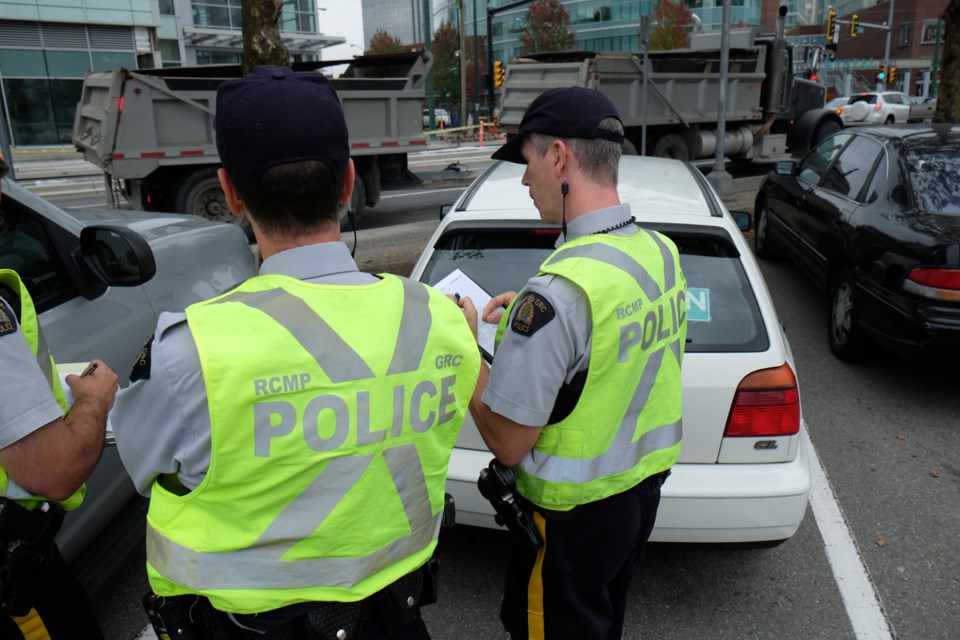While distracted driving is an ongoing problem throughout the Lower Mainland, one Burnaby sergeant says it is only part of a much bigger issue.
Earlier this month, ICBC and police services across Metro Vancouver launched a campaign targeting drivers who continue to use electronic devices behind the wheel. Burnaby RCMP is one of the police agencies that jumped on board but according to Sgt. Dave Bell of the department’s traffic services, the growing trend of inattentive driving is what’s really to blame.
“Inattentiveness is a systemic problem and that’s why I think the statistics are misleading because we focus on the use of cellphones but that’s not the only problem,” Bell told the NOW.
So far this year, Burnaby RCMP have issued 1,137 distracted driving tickets – nearly 400 in July and August alone – and in Bell’s opinion, these numbers are low because often officers can’t ticket or charge someone for inattentive driving because it would be too difficult to prove in court.
“You have collisions … where people aren’t paying attention to their driving. The difficulty is we simply can’t prove it because we can’t get the information from the driver themselves, they often don’t answer the question or they provide some other sort of excuse,” he said.
A number of examples come to mind when speaking about inattentive driving, Bell said.
One recent crash almost resulted in severe injury when a man, driving his two children, drove through the stop sign at 12th Avenue at Sixth Street. Travelling at full speed, Bell said the driver told investigators that because traffic wasn’t moving, he assumed the pedestrian-controlled traffic light had turned red. So rather than stopping at the stop sign, he drove through the intersection and crashed into a car travelling along Sixth Street.
“He went through it at 50 kilometres and then his vehicle hit so hard that it went up on two wheels and almost flipped over but didn’t, it came crashing down and almost hit pedestrians who were waiting to cross the street,” he said. “And this is just ‘Joe Blow’ father with his kids in the car going somewhere.”
These are types of accidents that leave investigators grasping at straws when it comes to proving inattentiveness. While charges can be laid against drivers for driving without due car or attention, it’s a hard charge to prove in court because it requires a lot of evidence, Bell said.
“It’s not impossible, but you have to have substantive evidence that will show the judge that the person didn’t just have a momentary lapse of judgment because there’s case law that says … a momentary lapse of attention does not constitute driving without due care or attention,” he said.
Momentary lapses could mean the driver was distracted by what he or she thought was an ambulance in their rearview mirror, while driving without due care or attention might be something like the driver was eating a burger and a piece of tomato fell into their lap, causing them to look away from the road.
“That’s a 20- or 30-second incident, and they could have gone through a stop sign or red light and run over five people in a crosswalk,” Bell said.
And the same logic applies to pedestrians, he added. With the winter months fast approaching, the shorter days, gloomy weather and limited visibility often caused by the Lower Mainland’s rainy season, are all factors in crashes and if drivers and pedestrians aren’t paying attention, the risk only grows, Bell added.
“December, January and February are the worst, I think, for pedestrian collisions, and we can’t stress enough the need for pedestrians to pay attention to where they’re crossing, when they’re crossing and who’s coming around the corners and to look and to wear appropriate clothing,” he said.
Last week, an 87-year-old woman was killed on Kingsway near Edmonds Street when she was hit by a car while jaywalking across the busy street.
“How did the driver not see this pedestrian coming across the roadway? The explanation that we were given was she was looking ahead at the light at Edmonds to see what was going on at the intersection,” he said. “Her sightline was distance driven, not directly in front of her, and missed this woman crossing the road.”
Despite the severity of this underlying problem, Bell said most police agencies continue to target electronics use rather than inattentiveness because it’s easier to prove.
In the meantime, Burnaby RCMP will continue with enforcement strategies in an effort to discourage people from using cellphones and keep their attentions focused on the road ahead.
“Whether the enforcement acts as a deterrent or not will only be known years down the road,” Bell said.
He likened the problem to seatbelt enforcement in the late ’80s and early ’90s. At the time, about 80 per cent of the population wore their seatbelts. Nearly 30 years later, the percentage of people who wear their seatbelts is in the mid-90 per cent.
The issue of inattentive and distracted driving came on the heels of recent advances in technology and is relatively new – it’s going to take some time to sink in, according to Bell.
“I suspect it’s going to take dozens of years to have people come around to understanding that it is extremely dangerous and they shouldn’t be doing it,” he said.



